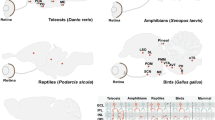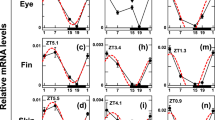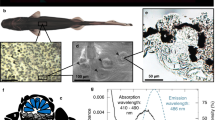Abstract
Circadian rhythms are controlled by endogenous oscillators or clocks. These clocks exhibit a persistent period of approximately 24 h in constant conditions, a specific phase relationship to a periodic cue (zeitgeber) in the external environment, and plasticity in that the phase of the clock may be altered in response to a phase change in the zeitgeber1. Although many processes exhibit circadian rhythmicity, the nature and location of endogenous clocks remain poorly defined. Recent evidence in vertebrates suggests that the mammalian suprachiasmatic nucleus and the avian pineal gland contain clocks that affect the rhythmicity of indoleamine metabolism2. The vertebrate retina also exhibits a circadian rhythm of serotonin N-acetytransferase activity (NAT, EC 2.1.1.4)3–5, a key enzyme controlling melatonin synthesis, and of photoreceptor disk shedding6,7. The latter process may be regulated by melatonin8, and the immediate cellular events seem to be controlled locally within the eye9–11. Although sustained oscillation and entrainment were not demonstrated, data suggesting that an ocular circadian clock influences disk shedding have been reported9. We sought evidence for an ocular clock by studying retinal NAT activity in Xenopus eye cups maintained in culture and report here both sustained oscillation and entrainment of the in vitro system. The data indicate that in addition to the suprachiasmatic nucleus and pineal gland, the eye itself must be regarded as the locus of a circadian clock in vertebrates.
This is a preview of subscription content, access via your institution
Access options
Subscribe to this journal
Receive 51 print issues and online access
$199.00 per year
only $3.90 per issue
Buy this article
- Purchase on Springer Link
- Instant access to full article PDF
Prices may be subject to local taxes which are calculated during checkout
Similar content being viewed by others
References
Aschoff, J. in Handbook of Behavioral Neurobiology Vol. 4 (ed. Aschoff, J.) 81–93 (Plenum, New York, 1981).
Takahashi, J. S. & Zatz, M. Science 217, 1104–1111 (1982).
Binkley, S., Reilly, K. B. & Hryschyshyn, M. J. comp. Physiol. 139, 103–108 (1980).
Hamm, H. E. & Menaker, M. Proc. natn. Acad. Sci. U.S.A. 77, 4998–5002 (1980).
Iuvone, P. M. & Besharse, J. C. Brain Res. (in the press).
La Vail, M. M. Science 194, 1071–1074 (1976).
Besharse, J. C., Hollyfield, J. G. & Rayborn, M. E. J. Cell Biol. 75, 507–527 (1977).
Besharse, J. C. & Dunis, D. A. Science 219, 1341–1343 (1983).
Tierstein, P. S., Goldman, A. I. & O'Brien, P. J. Invest. Ophthal. vis. Sci. 19, 1268–1273 (1980).
Hollyfield, J. G. & Basinger, S. F. Nature 274, 794–796 (1978).
Besharse, J. C., Terrill, R. O. & Dunis, D. A. Invest. Ophthal. vis. Sci. 19, 1512–1517 (1980).
Kasal, C. A. & Perez-Polo, J. R. J. Neurosci. Res. 5, 579–585 (1980).
Klein, D. C. & Weller, J. L. Science 169, 1093–1095 (1970).
Menaker, M. & Binkley, S. in Handbook of Behavioral Neurobiology Vol. 4 (ed. Aschoff, J.) 243–255 (Plenum, New York, 1981).
Redman, J., Armstrong, S. & Ng, K. T. Science 219, 1089–1091 (1983).
Reiter, R. J. Am. J. Anat. 162, 287–313 (1981).
Levinson, G. & Burnside, B. Invest. Opthal. vis. Sci. 20, 294–303 (1981).
Brandenburg, J., Bobbert, A. C. & Eggelmeyer, F. Behav. Brain Res. 7, 113–123 (1983).
Besharse, J. C. Prog. Retinal Res. 1, 81–124 (1982).
Flannery, J. G. thesis, Univ. California, Santa Barbara (1982).
Inouye, S. T. & Kuwamura, H. Proc. natn. Acad. Sci. U.S.A. 76, 5962–5966 (1979).
Binkley, S. A., Reibman, J. B. & Reilly, K. B. Science 202, 1198–1201 (1978).
Kasal, C. A., Menaker, M. & Perez-Polo, J. R. Science 203, 656–658 (1979).
Deguchi, T. Science 203, 1245–1247 (1979).
Jacklet, J. W. Science 164, 562–563 (1969).
Author information
Authors and Affiliations
Rights and permissions
About this article
Cite this article
Besharse, J., Iuvone, P. Circadian clock in Xenopus eye controlling retinal serotonin N-acetyltransferase. Nature 305, 133–135 (1983). https://doi.org/10.1038/305133a0
Received:
Accepted:
Issue Date:
DOI: https://doi.org/10.1038/305133a0
This article is cited by
-
Non-visual Opsins and Novel Photo-Detectors in the Vertebrate Inner Retina Mediate Light Responses Within the Blue Spectrum Region
Cellular and Molecular Neurobiology (2022)
-
CRISPR/Cas9 mediated mutation of the mtnr1a melatonin receptor gene causes rod photoreceptor degeneration in developing Xenopus tropicalis
Scientific Reports (2020)
-
Light pollution: the possible consequences of excessive illumination on retina
Eye (2016)
-
A New Arylalkylamine N-Acetyltransferase in Silkworm (Bombyx mori) Affects Integument Pigmentation
Applied Biochemistry and Biotechnology (2015)
-
Wiring the retinal circuits activated by light during early development
Neural Development (2014)
Comments
By submitting a comment you agree to abide by our Terms and Community Guidelines. If you find something abusive or that does not comply with our terms or guidelines please flag it as inappropriate.



